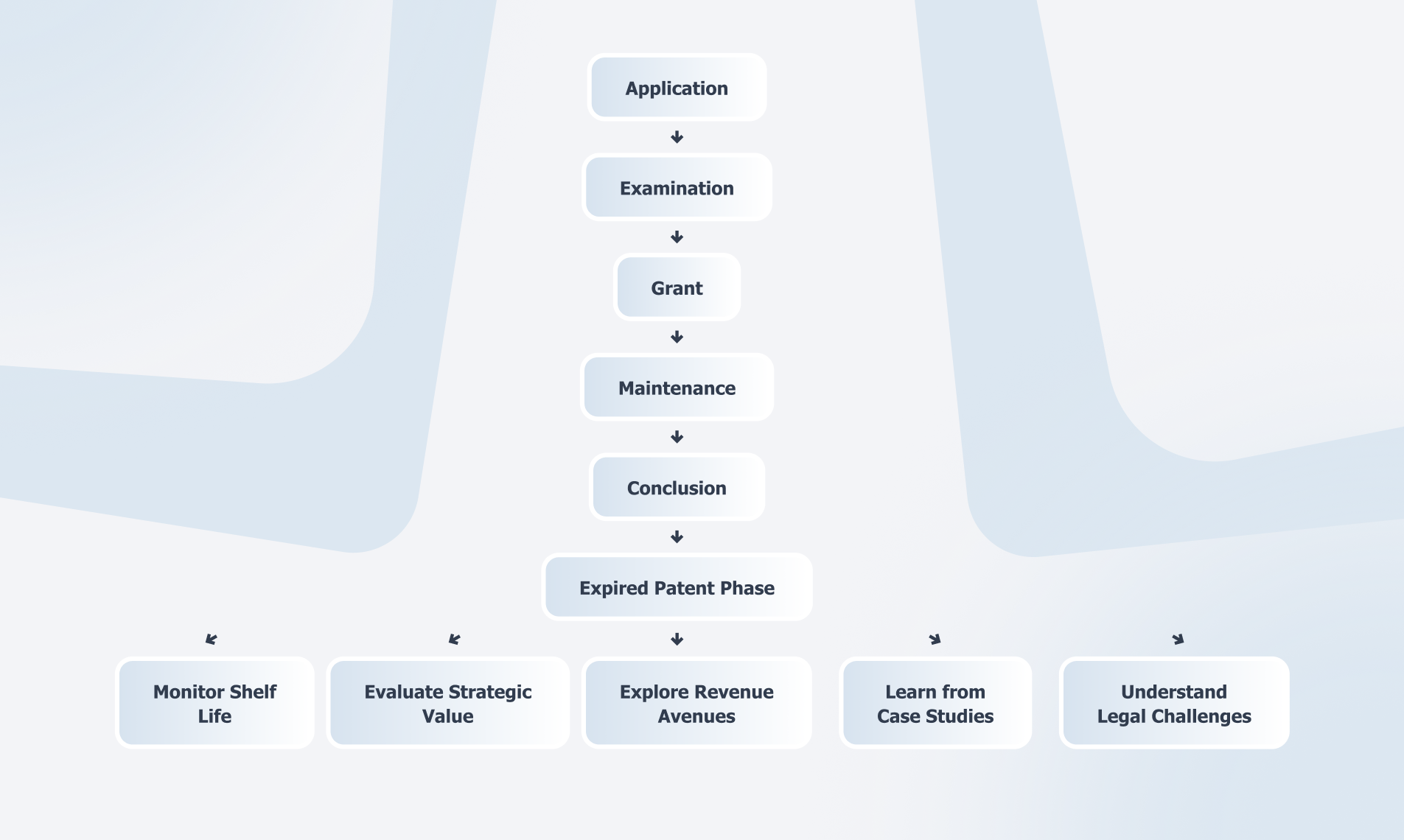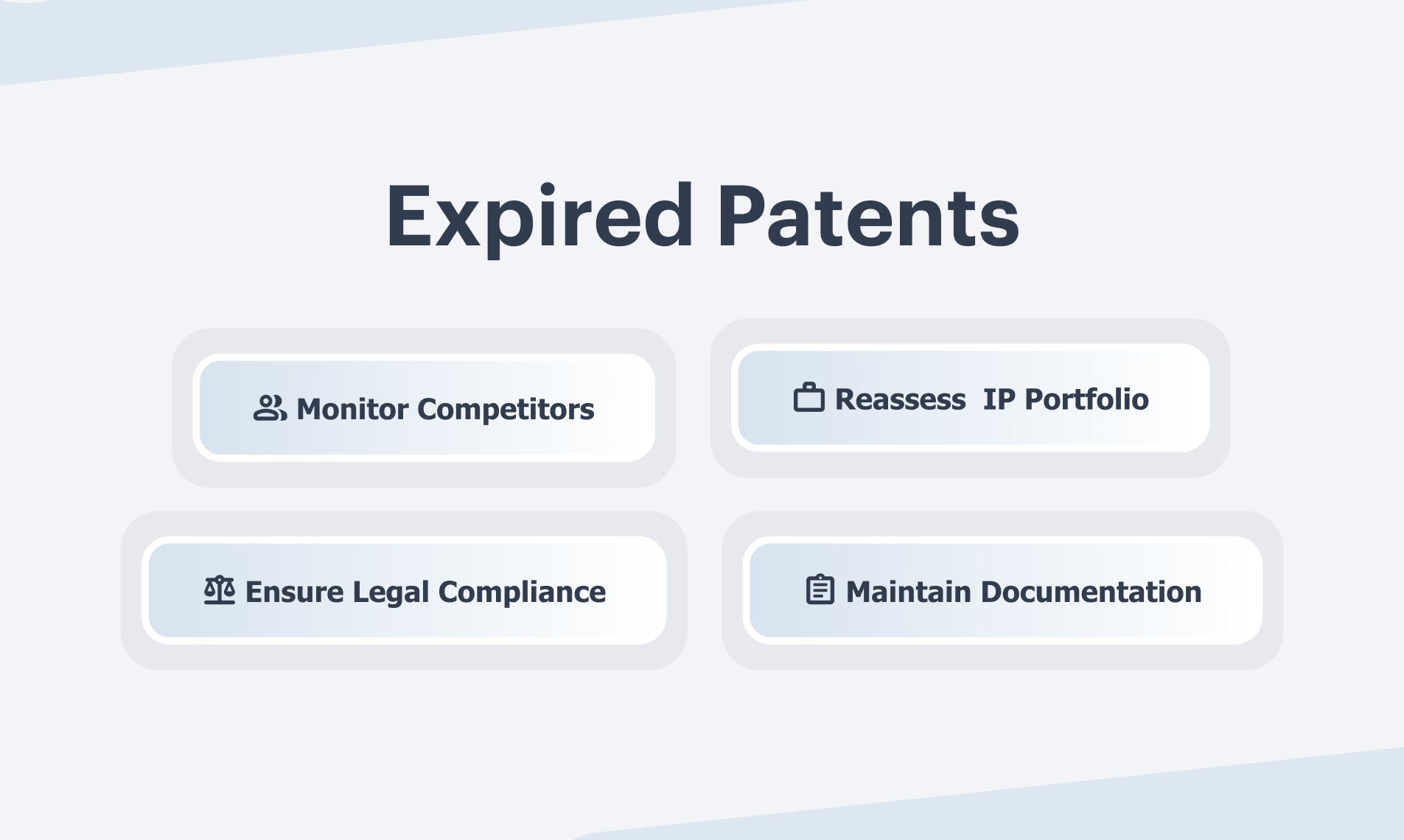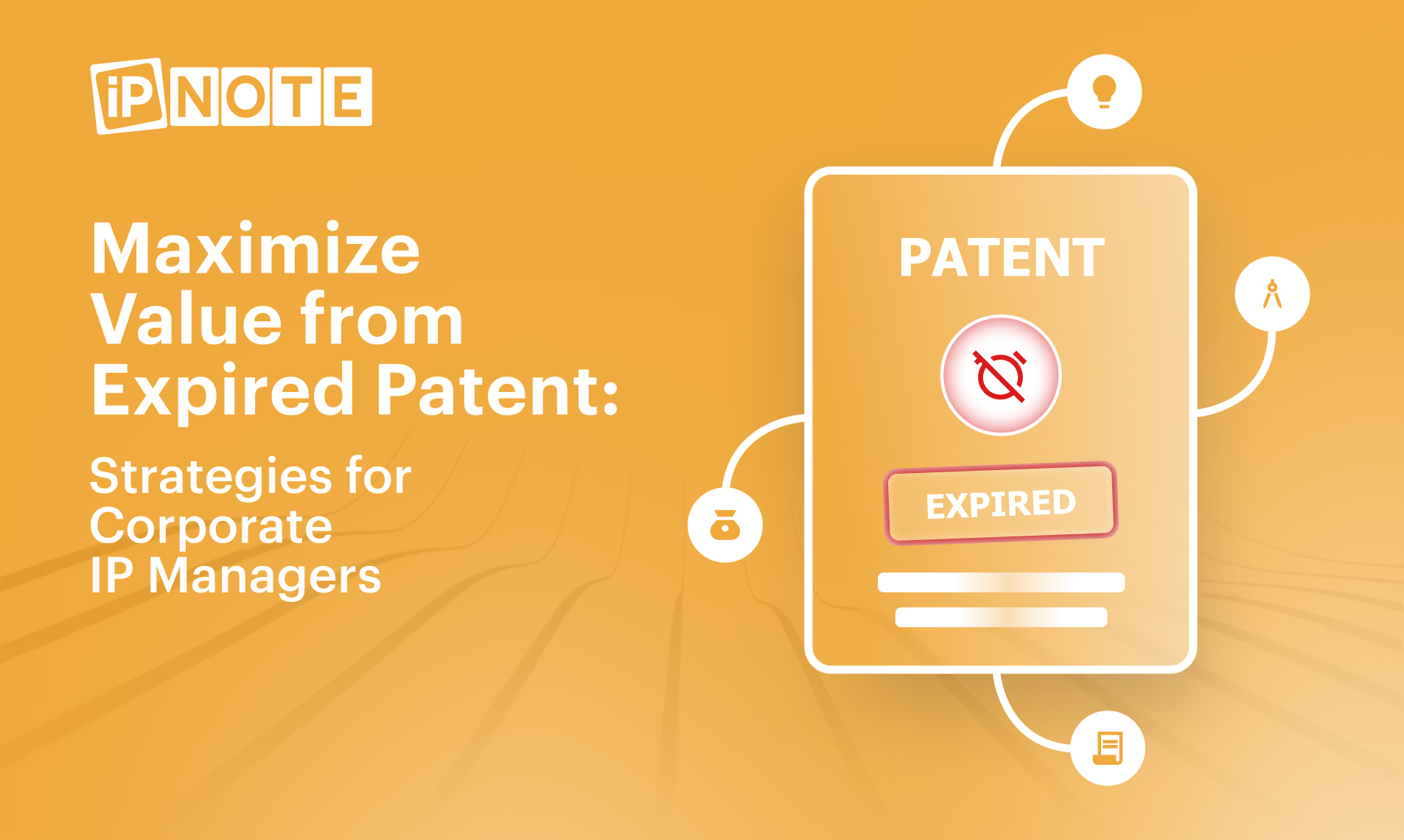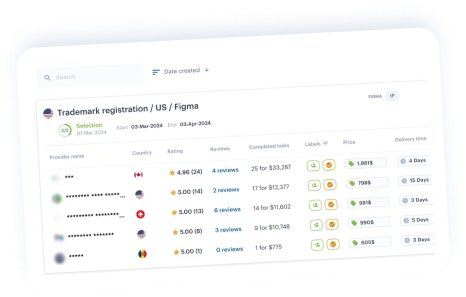Overview
This article presents essential strategies for corporate IP managers aiming to maximize value from expired patents. It underscores the critical need for proactive management and innovative approaches to leverage lapsed intellectual property effectively. Key tactics outlined include:
- Engaging in licensing agreements
- Conducting thorough market analysis
- Forming strategic collaborations
- Navigating complex legal considerations
These methods are designed to empower organizations to sustain growth and maintain a competitive edge following patent expiration. By implementing these strategies, companies can not only protect their interests but also unlock new opportunities for revenue generation and market positioning.
Introduction
In the intricate realm of intellectual property, grasping the lifecycle of patents is essential for corporate IP managers. As inventions advance through various stages—from application to expiration—the dynamics of competition and revenue generation undergo significant transformations. The expiration phase, in particular, converts once-protected technologies into public domain assets, presenting both challenges and opportunities.
With competitors ready to leverage these innovations, it becomes imperative for organizations to navigate this landscape with strategic foresight.
This article explores effective strategies for managing patent expirations, maximizing value from expired patents, and addressing the legal considerations that arise, ensuring that companies not only endure but flourish amidst evolving market conditions.
Understand the Lifecycle of Patents and Expiration Implications
The intellectual property lifecycle encompasses several critical phases: application, examination, grant, maintenance, and conclusion. Each stage presents unique opportunities and challenges that corporate IP managers must adeptly navigate. A pivotal aspect of this lifecycle is the expired patent phase, which marks the transition of the invention into the public domain. Once legal protection lapses due to an expired patent, competitors gain unrestricted access to the technology, often resulting in heightened competition and potential revenue loss for the original holder. For instance, in 2023, the medical and dental fields alone accounted for over 11,000 inventions, underscoring the competitive landscape that emerges post-expiration.
To mitigate the risks associated with patent expiration, corporate IP managers should consider the following strategies:
- Diligently Monitor Shelf Life: Tracking shelf life is essential for timely decision-making. By utilizing iPNOTE’s AI-driven features, managers can automate reminders and alerts, ensuring that no critical deadlines are overlooked.
- Evaluate Strategic Value: Assessing the ongoing value of patents throughout their lifecycle is crucial to determine if renewal or other actions are warranted. iPNOTE facilitates easy integration of service providers, enabling managers to consult with intellectual property attorneys for expert evaluations while promoting seamless communication.
- Explore Innovative Revenue Avenues: Following the expired patent, licensing agreements or strategic partnerships can be explored to generate revenue from previously patented technologies. iPNOTE’s platform streamlines the negotiation process, enhancing collaboration with potential partners.
- Learn from Case Studies: The study titled “Long-Term Implications of Patent Expiry” illustrates how innovator companies adapt their strategies to sustain growth and profitability in competitive markets after expiration.
- Understand Legal Challenges: The Recentive v. Fox case exemplifies the significance of eligibility criteria, highlighting the difficulties encountered throughout the intellectual property lifecycle.
By implementing these strategies and leveraging iPNOTE’s features, corporate IP managers can more effectively prepare their organizations to capitalize on opportunities and address challenges arising from the conclusion of intellectual property rights. Effectively managing expired patents not only supports sustained growth but also aids in preserving a competitive advantage in the market.

Implement Strategies to Maximize Value from Expired Patents
To maximize benefits from lapsed intellectual property, corporate IP managers should implement several key strategies:
- Licensing Agreements: Engaging in licensing discussions with businesses interested in utilizing the technology can generate income without the expenses associated with maintaining a trademark. Licensing agreements can significantly enhance profitability, as evidenced by the growing trend of companies leveraging lapsed intellectual property to create new revenue streams. Mark H Rozenbaum from Pfizer, Inc. noted that higher revenues prior to the expiration of intellectual property rights may lead to increased generic competition after the expired patent, resulting in lower prices. This highlights the critical nature of strategic licensing in sustaining revenue.
- Market Analysis: Conducting comprehensive market research is vital for identifying gaps that lapsed intellectual property can address. This analysis can facilitate new product development or improvements to existing products, ensuring that the technology remains relevant and valuable in the marketplace. A recent study revealed that the median price ratio for drugs with orphan designation 48 months after exclusivity expiration was merely 0.11, indicating a substantial opportunity for companies to innovate and capture market share by addressing these gaps.
- Collaborations: Forming strategic alliances with entities that can benefit from the lapsed intellectual property allows for shared resources and reduced risks. Partnerships can yield innovative solutions that leverage the strengths of both parties, maximizing the potential of the outdated intellectual property. Furthermore, innovation pools can consolidate intellectual properties from multiple holders, lowering transaction costs and ensuring access to essential technologies, thereby enhancing partnership opportunities. Utilizing an expired patent as a foundation for new advancements represents a powerful strategy. By refining the original creation, businesses can file new applications and regain market exclusivity. This approach not only revitalizes the technology but also positions the organization as a leader in innovation. The notable increase in AI-related intellectual property submissions, which surged by 40% from 2019 to 2020, exemplifies how businesses can leverage lapsed rights in the realm of new technologies to drive innovation.
- Cost Reduction: Integrating outdated intellectual properties into research and development processes can markedly decrease expenses related to licensing fees or royalties. This enables a more effective allocation of budget towards innovation, fostering a culture of creativity and progress within the organization.
By implementing these strategies, corporate IP managers can effectively harness outdated intellectual property to drive growth and maintain a competitive edge in their respective fields.
Navigate Legal Considerations and Actions for Expired Patents
Navigating the legal landscape surrounding expired patents necessitates a clear understanding of the rights and limitations that emerge once a registration expires. Upon the expiration of a copyright, the associated invention enters the public domain, allowing anyone to use, produce, or sell it without the need for permission. However, it is essential to verify that no active rights overlap with the lapsed one to avoid potential infringement issues.
Corporate IP managers should consider the following strategic actions:
- Monitoring Competitors: Vigilantly observe competitors who may exploit the lapsed intellectual property. This proactive approach enables your company to respond effectively and maintain a competitive edge.
- Reassessing IP Portfolio: Conduct regular reviews of the IP portfolio to identify intellectual properties nearing expiration. Developing strategies to maximize their value before they lapse is crucial for sustaining a robust IP strategy.
- Legal Compliance: Adhere to all applicable laws and regulations when utilizing outdated intellectual property, particularly in sectors with stringent regulatory frameworks. This compliance is vital to mitigate legal risks.
- Documentation: Maintain comprehensive records of all actions taken regarding the expired patent. Thorough documentation serves as a safeguard for the company in the event of disputes or legal challenges.
Statistics reveal that inventions entering the public domain can significantly influence market dynamics. For instance, a longitudinal study on drug prices following patent termination, utilizing data from the IQVIA MIDAS database for the period from 2011 to 2020, uncovered substantial price reductions across high-income countries. This underscores the importance of understanding these dynamics in economic evaluations and informs strategic decisions for corporate IP managers. Additionally, specialist perspectives emphasize that among rights with prolonged durations, the typical extension is approximately 392 days, highlighting the necessity for strategic planning as the expiration date approaches. As Ankush Sharma, a Senior Research Analyst, observed, “Among those with a prolonged term, the average extension is 392 days,” which underscores the importance of planning for expirations.
Furthermore, the significance of plant protections for breeders and agricultural firms cannot be overlooked, as these protections are essential for recouping investments in developing new plant varieties. By efficiently navigating these legal factors and implementing proactive strategies, corporate IP managers can enhance the value derived from lapsed intellectual property while safeguarding their company’s interests. Moreover, establishing a future research agenda based on insights from expired patents can further enhance strategic planning and adaptability in a rapidly evolving market.

Conclusion
Understanding the lifecycle of patents and the implications of expiration is paramount for corporate IP managers striving to navigate the intricate landscape of intellectual property. As patents transition into the public domain, organizations encounter both challenges from heightened competition and opportunities for innovation and revenue generation. By diligently monitoring expiration dates, evaluating the strategic value of patents, and exploring innovative revenue avenues, companies can adeptly manage the risks associated with patent expirations.
Maximizing value from expired patents necessitates strategic actions, including:
- Engaging in licensing agreements
- Conducting thorough market analyses
- Forming advantageous partnerships
These approaches not only enhance profitability but also cultivate innovation, enabling organizations to leverage expired patents as a springboard for new developments. Furthermore, incorporating expired patents into research and development processes can yield significant cost reductions, empowering companies to allocate more resources toward creativity and advancement.
Navigating legal considerations is equally crucial in this domain. Corporate IP managers must vigilantly monitor competitor activities, reassess their IP portfolios, and ensure compliance with applicable laws. By maintaining meticulous documentation and comprehending market dynamics post-expiration, organizations can safeguard their interests while optimizing the value derived from expired patents. Ultimately, by adopting these strategies and remaining proactive, corporate IP managers can ensure their organizations not only endure but thrive in an ever-evolving market.
Unlock Hidden Value from Expired Patents Today! Start using iPNOTE to transform challenges into opportunities for growth and innovation.
Frequently Asked Questions
What are the main phases of the intellectual property lifecycle?
The main phases of the intellectual property lifecycle are application, examination, grant, maintenance, and conclusion.
What happens during the expired patent phase?
The expired patent phase marks the transition of the invention into the public domain, allowing competitors unrestricted access to the technology, which can lead to increased competition and potential revenue loss for the original holder.
How many inventions were accounted for in the medical and dental fields in 2023?
In 2023, the medical and dental fields accounted for over 11,000 inventions.
What strategies can corporate IP managers use to mitigate risks associated with patent expiration?
Corporate IP managers can use several strategies, including: 1. Diligently monitoring shelf life with automated reminders. 2. Evaluating the strategic value of patents throughout their lifecycle. 3. Exploring innovative revenue avenues through licensing agreements or partnerships. 4. Learning from case studies on the implications of patent expiry. 5. Understanding legal challenges highlighted by specific cases.
How can iPNOTE assist corporate IP managers in managing patents?
iPNOTE provides AI-driven features for tracking shelf life, facilitates the integration of service providers for expert evaluations, streamlines negotiation processes for licensing agreements, and offers insights from case studies.
What is the significance of the Recentive v. Fox case?
The Recentive v. Fox case highlights the importance of eligibility criteria and the difficulties encountered throughout the intellectual property lifecycle, emphasizing the legal challenges faced by IP managers.
Why is it important to manage expired patents effectively?
Effectively managing expired patents supports sustained growth and helps preserve a competitive advantage in the market by allowing organizations to capitalize on opportunities and address challenges that arise after the expiration of intellectual property rights.






